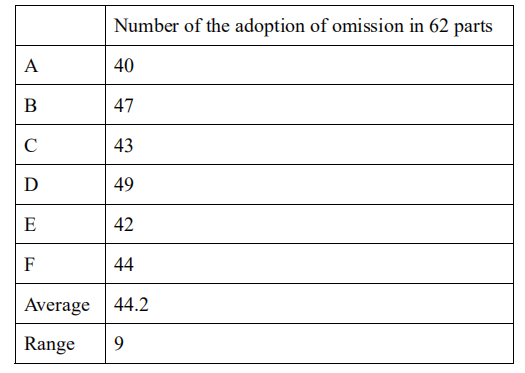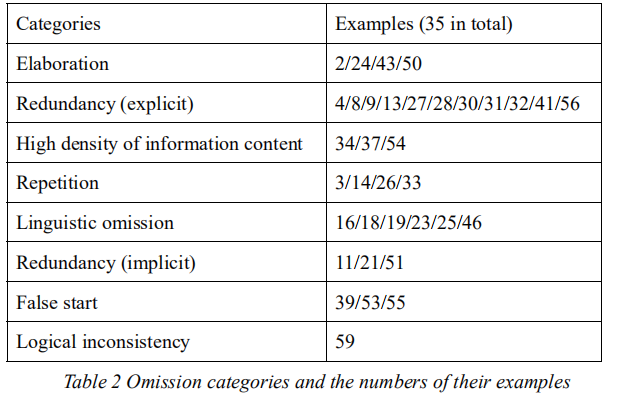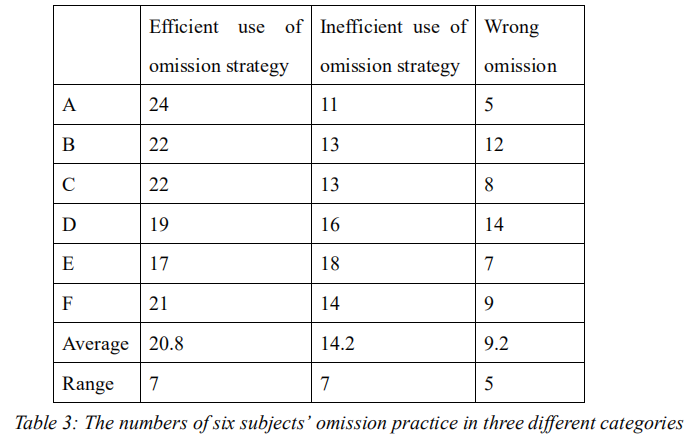Acknowledgements
Thanks for all the teachers in the Department of English who instructed me ininterpreting during my two-years' study as a postgraduate student in China ForeignAffairs University.
Thanks for my supervisor, Associate Professor He, who has provided me withvaluable advice in terms of thesis structure and content over the past months.
Thanks for all the students who participated in the experiment. Wish you all abright future.
Thanks for my roommates, who make me enjoy my life at school.
Thanks for my parents and friends. It's you that keep encouraging me during thedark time and make me get ready for a new life. Love you all.
Abstract
As interpreters are faced with multiple pressures of listening, understanding andprocessing concurrently when performing simultaneous interpreting, there is a growingtrend of adopting omission strategy that preserves the key information of sourcelanguage and deletes something less relevant so as to ease interpreters' burden of effortdistribution and make their output more concise.
However, as most of the past studies were made to prove the necessity of adoptingomission strategy and conclude its advantages but barely focused on the problems thatinterpreters, especially interpreting trainees may encounter in their simultaneousinterpreting practices, this thesis aims to explore the practice of omission strategy andfind the possible reasons behind both efficient and inefficient practices of omissionstrategy by interpreting trainees. The research was made based on a C-E simultaneousinterpreting experiment where 6 second-year interpreting postgraduates with at leasthalf-a-year related training, were required to interpret a 2000-word speech featured withless formal expressions. Then subjects were interviewed respectively by the author toshare their own attitudes towards omission and evaluate their interpreting performancein the experiment in terms of the practice of omission strategy.
Based on both the experiment result and interviews with each subject, the authorhas drawn several valid conclusions. First, generally speaking, interpreting traineeshave a good command of omission strategy in a C-E simultaneous interpreting; Second,false start and repetition are two categories that are most likely to be practiced withefficient omission. High density of information content, explicit redundancy,elaboration and linguistic omission follow in order; Third, logical inconsistency andimplicit redundancy are two categories that are hard to be adopted with omissionstrategy; Four, efficient omission practices basically result from subjects' goodunderstanding of omission strategies, which is accumulated through their own relatedexperiences, while the reasons for those ill practices are various academically.
Corresponding to the problems concluded above, both academic and mental suggestions are made by the author for future studies in this field and efficient practicesof omission strategies in C-E simultaneous interpreting.
Key words: C-E simultaneous interpreting, omission strategy, interpreting novices
摘要
由于同传译员在进行时间有限的同传实践中,会同时面临听、理解以及语句处理等多重压力,因此其越来越倾向使用省译翻译策略,在保留源语言主要内容的同时舍弃关联度低的信息,以此来缓解译员精力分配的负担并使其译文更为简洁.
然而,在同传省译策略领域,过往的研究多集中在证实省译策略的必要性及重要性而较少关注在译员尤其是口译学生在实践省译策略时会面临的问题.因此,本论文旨在探索汉英同传中省译策略运用的情况,找出口译学生成功或失败实践省译策略背后的原因.研究以汉英同传实验的方式开展,实验对象是六名口译专业研究生二年级的学生,其均接受过至少半年的口译训练.实验对象被要求同传翻译出一篇 2000 字口语化为主的演讲.之后,实验对象接受笔者采访,分享其对于省略的态度并从省译策略的角度评估个人口译实验表现.
基于实验结果及对实验对象的采访内容,笔者得出以下总结.第一,总的来说,口译学生在汉英同传中对省译策略的使用有良好的掌握;第二,句首错误和词句重复为最易处理的两种情况.句子信息密集、显性重复、详细描述和语言省略紧随其后;第三,逻辑错误和隐性重复是最难实践省译策略的两类;第四,实验对象成功实践省译策略的原因是基于其通过大量经验累计的对省译策略的良好理解,而失败原因则更为学术化多样.
基于上述问题,笔者也提出了学术和心理两方面的相关建议,便于未来该领域的研究及省译策略在同传中的有效实践.
关键词:汉英同传,省译策略,口译学习者
Contents
Acknowledgements .......................................................................................................................... II
Abstract ........................................................................................................................................... III
摘要 ................................................................................................................................................. V
Chapter 1 Introduction ...................................................................................................................... 1
1.1 Research background .......................................................................................................... 1
1.2 Research purpose ................................................................................................................ 2
1.3 Thesis structure ................................................................................................................... 2
Chapter 2 Literature Review ............................................................................................................. 4
2.1 Language difference between Chinese and English ............................................................ 4
2.2 Simultaneous interpretation ................................................................................................ 5
2.2.1 Process of simultaneous interpreting ........................................................................ 6
2.2.2 Features of SI ........................................................................................................... 7
2.2.3 Gile's Effort Model in SI ......................................................................................... 7
2.3 Omission strategy in SI ....................................................................................................... 8
2.3.1 The definition of omission strategy .......................................................................... 8
2.3.2 The advantages and necessity of omission strategy ................................................. 9
2.3.3 Categories of omission strategy ............................................................................... 9
Chapter 3 Experiment ..................................................................................................................... 12
3.1 Experiment design ............................................................................................................. 12
3.1.1 Text for model C-E SI ............................................................................................ 12
3.1.2 Subjects of model C-E SI ....................................................................................... 12
3.2 Result of experiment ......................................................................................................... 13
3.3 Analysis ............................................................................................................................. 16
3.3.1 Motivations behind efficient omission strategy ..................................................... 16
3.3.2 Reasons behind inefficient use of omission strategy .............................................. 22
Chapter 4 Conclusion ...................................................................................................................... 27
4.1 Findings and suggestions .................................................................................................. 27
4.2 Limitations ........................................................................................................................ 28
Bibliography ................................................................................................................................... 30
Appendix 1 ...................................................................................................................................... 32
Appendix 2 ...................................................................................................................................... 51
Appendix 3 ...................................................................................................................................... 55
Chapter 1 Introduction
Chapter 1 gives a brief introduction to the whole thesis in terms of researchbackground, research purpose and thesis structure.
1.1 Research background
There is a growing number of international meetings in today's everinterdependent world. As simultaneous interpretation can improve the efficiency bymaintaining the continuity of the meeting, it comes to be popular in the internationalmeetings. As a result, we can see a large demand for high-quality simultaneousinterpreters who can manage their effort distribution well and ensure their rendition ofabout or over 80% accuracy. To order to satisfy the requirements above, the efficientpractice of omission is necessary.
In that scenario, omission is not used to leave out the useful information butfunctions as a strategy by maintaining the key information of the source language anddeleting something less relevant, redundant or even wrong. In this way, even faced withmultiple pressures of listening, understanding and processing concurrently,simultaneous interpreters can comparatively ease themselves and leave certain time forthe rendition of the following words. At the same time, omission as a conscious andhelpful decision made by the interpreters rather than a mistake resulted frommiscomprehension will also make the rendition more concise and coherent (Viaggio2002; Vission 2005; Pym 2008). Despite the definition and advantages of omissionstrategy, eight circumstances that require the practice of omission were concluded byZhang Ling in 2002. However, the previous studies of omission strategy were mainlyabout its value but barely focused its practice by interpreters, especially theinexperienced interpreting trainees.
At the same time, although it is necessary omit something to make the renditionmore idiomatic in Chinese to English simultaneous interpretation, the intrinsicdifference in the language organization can make it hard to complete the whole procedure. In this condition, it's interesting and beneficial to interpreting trainees' practice of omission strategy in the Chinese to English simultaneous interpretation.
1.2 Research purpose
Based on the previous studies on both simultaneous interpreting and the practiceof omission strategy in simultaneous interpretation, we are informed of the difficulty ofeffort distribution in simultaneous interpreting and importance of omission strategiesas well as specific occasions where they are necessary. However, when omission isproved necessary, how its practice of interpreters, especially those inexperiencedinterpreting trainees will be.
As a result, the author decides to evaluate interpreting trainees' practice ofomission strategy by conducting a model Chinese to English simultaneousinterpretation with the participation of six interpreting trainees. After the experiment,each subject will be interviewed to share their ideas about omission strategies. Basedon both the valid experiment result and the personal ideas, the author aims to solve thefollowing problems:
1.In what kind of situations interpreting trainees can/cannot efficiently adoptomission strategy?
2.What are the motivations behind the efficient practice of omission strategy?
3.What are the reasons behind the inefficient practice of omission strategy?
1.3 Thesis structure
This thesis is comprised of four chapters as follows:
Chapter One presents the overview of the whole thesis by introducing the researchbackground, the research purpose and the thesis structure.
Chapter Two reviews the previous studies of simultaneous interpretation and thedifferences between Chinese and English to show the necessity and importance ofomission strategy. At the same time, more related information including the definitionof omission strategy and several omission categories will be concluded in this chapter.
Chapter Three, as the body of this thesis, detail the whole procedure of the modelChinese to English simultaneous interpreting from preparation, data analysis to reasonsexplorations.
Chapter Four concludes both the major findings and the limitations of the thesis.
…………由于本文篇幅较长,部分内容省略,详细全文见文末附件



Chapter 4 Conclusion
This chapter concludes the major findings of the experiment and presents thelimitations of the thesis.
4.1 Findings and suggestions
Several conclusions can be made based on the experiment result, the analysis aswell as the interviews with all the subjects.
First, there are on average 66% possibilities for subjects to apply omission strategyto the eight omission categories from the 35 sentences, which implies that interpretingtrainees can possess a generally good control of omission strategy in Chinese to Englishsimultaneous interpreting.
Second, six out of the eight omission traps can be applied with omission strategyefficiently by the six subjects in most conditions with false start and repetition as theeasiest two, standing at 89% and 83% respectively. They are followed by high densityof information content at 78%, explicit redundancy at 73%, elaboration and linguisticomission at 58%. The reasons behind those efficient practices of omission can beinterpreting trainees' moderate evs, the pursuit of conciseness without restatement, theconsciousness and capability of catching the main information and so on, all of whichare cultivated through interpreters' own practices and self-evaluations.
Third, logical inconsistency and implicit redundancy are two categories thatinterpreting trainees cannot properly apply omission strategy to in over 50%simultaneous interpretation, with the inefficient rates of 83% and 56% respectively. Andas the situations of such inefficient practices of omission can be concluded as omittingit all and interpreting it all, the reasons behind can be different.
In the former scenario, interpreting trainees tend to suffer from the commonproblem of effort distribution. As the speech continues for several minutes, interpretingtrainees come to lag far behind the speaker. The multiple burdens of short-term memory,listening, understanding as well as processing tend to force them to omit randomly so as to fill the previous gap and catch up with the ongoing or upcoming words.
In the latter scenario, specific reasons can be found in the two categories. One isthat interpreting trainees tend to place no doubt on what the speaker delivers. In such acondition, they may maintain what the speaker say in their rendition, even if the speechcontains wrong expressions or logic problems. At the same time, the typical Chineseloose sentence structure makes it harder for the trainees to locate the sentence logic.The other reason is that implicit redundancy is always involved with certain culture andget expressed in a more obscure way, which requires both a good control of interpreters' mother tongue and the capability of a higher language flexibility.
Based on the findings above, it is suggested that interpreting trainees need practicemore Chinese to English simultaneous interpreting so as to pursue a better control ofeffort distribution, short-term memory and other interpreting skills. At the same time,from the mental perspective, interpreting trainees should build a positive mentalitytowards simultaneous interpretation by not being afraid of this challenging task andaiming higher to deliver an excellent interpreting output.
4.2 Limitations
In terms of the limitations of this study, there are several points worth noticing:
First, the number of the experiment subjects (6) is not enough, which makes theexperiment result not convincing enough in the field of the adoption of omissionstrategy in C-E simultaneous interpreting for interpreting trainees. The more subjects,the more valid and convincing findings.
Second, the example number of each omission category is not fixed. For instance,the number of explicit redundancy is eleven, while that of logical inconsistency is onlyone. The gap between the most and the fewest is 10. In such a condition, one successfulor unsuccessful omission practice of the omission category with fewer examples ismore decisive than that with more examples, which can make the priority of all theeight categories in terms of the efficient practice of omission strategy less convincingand valid.
Except for all the limitations and weaknesses, this thesis aims to provide somebeneficial information for future study in the field of omission adoption. Moreimportantly, by locating the problems in the practices of omission strategy in C-E SI,we hope that more interpreting trainees can practice omission strategy efficiently so asto improve the quality of their simultaneous interpretation.
Bibliography
Altman, Janet. "Error analysis in the teaching of simultaneous interpretation: A pilotstudy". In S. Lambert and B. Moser-Mercer (eds) Bridging the gap: Empiricalresearch in simultaneous interpretation. Amsterdam and Philadelphia: JohnBenjamins., 1994.
Barik, Henri C. "A description of various types of omissions, additions and errors oftranslation encountered in simultaneous interpenetration". In S. Lambert and B.
Moser-Mercer (eds) Bridging the gap: Empirical research in simultaneousinterpretation. Amsterdam and Philadelphia: John Benjamins., 1994.
Chernov, G.V., "Message Redundancy and Message Anticipation in SimultaneousInterpretation", in Lambert, S. & Mercer, B.M., Bridging the gap: Empiricalresearch in simultaneous interpretation. Amsterdam and Philadelphia: JohnBenjamins., 1994.
Diriker, Edu. De/Re-contextualizing Conference Interpreting. Amsterdam andPhiladelphia: John Benjamins., 2004.
Gerver, D., Empirical Studies of SI: A review and a Model. Translation: Applicationsand Research. Ed. R.Brisfin, New York: Gardner., 1976.
Gile, Daniel. Basic Concepts and Models for Interpreter and Translator Training.
Amsterdam/Philadelphia: John Benjamins Publishing Company., 1995.
Gile, Daniel. Opening up in Interpretation Studies. Amsterdam and Philadelphia: JohnBenjamins, 1994.
Gile Daniel. "Testing the Effort Models' tightrope hypothesis in simultaneousinterpreting - a contribution". Paris, Universite Paris 3 Sorbonne Nouvelle., 1992.
Pawel, Korpal. Omission in simultaneous interpreting as a deliberate act. Poland, AdamMickiewicz University, 2012.
Pinkham, J. The Translators' Guide to Chinglish. Beijing: Foreign Language Teaching& Research Press., 1998.
Pochhacker, Franz. Introducing Interpreting Studies. London: Routledge, 2004.
Pym, Anthony. "On omission in simultaneous interpreting: Risk analysis of a hiddeneffort". In G. Hansen et al. (eds) Efforts and models in interpreting and translationresearch: A tribute to Daniel Gile. Amsterdam and Philadelphia: John Benjamins.,2008.
Robin, Setton. Simultaneous Interpretation: A Cognitive-Pragmatic Analysis.Amsterdam and Philadelphia: John Benjamins Publishing Company., 1999.
Sunnari, Marianna. Processing Strategies in Simultaneous Interpreting: 'Saying It All'vs. Synthesis. In Tommok, ed. Topics in Interpreting Research, Turku: Universityof Turku Press., 1995.
Viaggio, Serigio. "The quest for optimal relevance: The need to equip students with apragmatic compass". In G. Garzone and M. Viezzi (eds) Interpreting in the 21stcentury: challenges and opportunities. Amsterdam and Philadelphia: JohnBenjamins., 2002.
Vission, Lynn. "Simultaneous interpretation: Language and cultural difference". In S.Bermann and M. Wood (eds) Nation, Language and the Ethics of Translation. Princeton: Princeton University Press, 2005.
张凌,"论同声传译中的省译",广州:广东外语外贸大学,2002.
仲伟合,《英语同声传译教程》,北京:高等教育出版社,2008.
仲伟合、詹成,《同声传译》,北京:外语教学与研究出版社,2009.